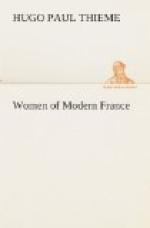By spending so much of her time at the salons of Mme. de Polignac and the Princesse de Guemenee, the queen excited the displeasure and enmity of many of the court and the people; at those places, De Besenval, De Ligny, De Lauzun,—men of the most licentious habits and expert spendthrifts,—seemed to enjoy her intimate friendship, a state of affairs which caused many scandalous stories and helped to alienate some of the greatest houses of France. This injudicious display of preference for her own circle of friends also fostered a general distrust and dislike among the people. The first families of France preferred to absent themselves from her weekly balls at Versailles, since attendance would probably result in their being ignored by the queen, who permitted herself to be so engrossed by a bevy of favorites and her own amusements as scarcely to notice other guests.
Her eulogists find excuse for all this in her lightness of heart and gay spirits, as well as in the manner of her rearing, having been brought up in the court of Louis XV., where she saw shameless vice tolerated and even condoned. Although she preserved her virtue in the midst of all this dissipation, she became callous to the shortcomings of her friends and her own finer perceptions became blunted. Thus, in the most critical years of her reign, her nobler nature suffered deterioration, which resulted fatally.
Despite many warnings, she could not or would not do without those friends. She excused anything in those who could make themselves useful to her amusement: everyone who catered to her taste received her favor. M. Rocheterie, in his admirable work, The Life of Marie Antoinette, gives as the source of her great love of pleasure her very strongly affectionate disposition,—the need of showering upon someone the overflowing of an ardent nature,—together with the desire for activity so natural in a princess of nineteen. As a place in which to vent all these emotions, these ebullitions of affections and amusements, the king presented her with the chateau “Little Trianon,” where she might enjoy herself as she liked, away from the intrigues of court.
Marie Antoinette has become better known as the queen of “Little Trianon” than as a queen of Versailles. At the former place she gave full license to her creative bent. Her palace, as well as her environments, she fashioned according to her own ideas, which were not French and only made her stand out the more conspicuously as a foreigner. From this sort of fairy creation arose the distinctively Marie Antoinette art and style; she caused artists to exhaust their fertile brains in devising the most curious and magnificent, the newest and most fanciful creations, quite regardless of cost—and this while her people were starving and crying for bread! The angry murmurings of the populace did not reach the ears of the gay queen, who, had she been conscious of them, might have allowed her bright eyes to become dim for a time, but would have soon forgotten the passing cloud.




